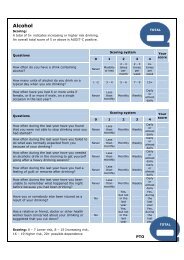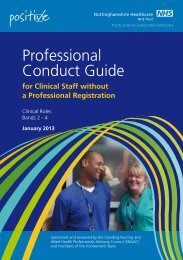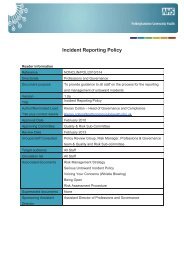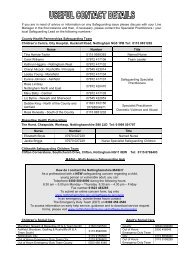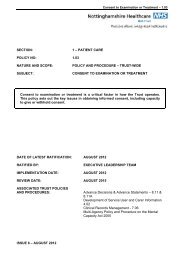Prevention and Control of Infections - Standard Precautions Policy
Prevention and Control of Infections - Standard Precautions Policy
Prevention and Control of Infections - Standard Precautions Policy
You also want an ePaper? Increase the reach of your titles
YUMPU automatically turns print PDFs into web optimized ePapers that Google loves.
<strong>Prevention</strong> & <strong>Control</strong> <strong>of</strong> <strong>Infections</strong> - St<strong>and</strong>ard <strong>Precautions</strong> – 18.12<br />
7.2.7 Inappropriate use <strong>of</strong> gloves increases the wearer’s exposure to the chemicals <strong>and</strong><br />
accelerants in the glove material which can result in skin sensitization. Gloves<br />
should only be worn when risk <strong>of</strong> contact with blood or body fluids.<br />
7.3 Disposable Plastic Aprons<br />
7.3.1 Disposable plastic aprons must be worn when there is a risk that clothing may<br />
become exposed to blood, body fluids, secretions or excretions onto the clothing <strong>of</strong><br />
staff, with the exception <strong>of</strong> sweat or when close/direct contact may lead to<br />
contamination by microbes from the patient, materials or equipment. Plastic aprons<br />
should be worn as single use items for one episode <strong>of</strong> patient care <strong>and</strong> then disposed<br />
<strong>of</strong> as clinical waste.<br />
7.3.2 Full body repellant gowns or suits must be worn where there is risk <strong>of</strong> EXTENSIVE<br />
splashing <strong>of</strong> blood, body fluids, secretions <strong>and</strong> excretions, with the exception <strong>of</strong><br />
sweat, onto the skin <strong>of</strong> health care workers.<br />
7.3.3 Gloves <strong>and</strong> aprons must also be worn whenever attending patients in source<br />
isolation.<br />
7.4 Face Masks/Eye Protection<br />
7.4.1 Face masks <strong>and</strong> eye protection or a full face visor must be worn where there is a risk<br />
<strong>of</strong> blood, body fluids, secretions <strong>and</strong> excretions splashing into face, mouth <strong>and</strong>/or<br />
eyes or when clinically indicated.<br />
7.4.2 Respiratory protective equipment e.g. a face mask should be used when clinically<br />
indicated. For the care <strong>of</strong> patients with smear positive Tuberculosis or influenza, high<br />
efficiency filter masks (FFP3 respirator masks) must be worn during cough induction<br />
or prolonged close contact (within one metre). These masks must also worn when<br />
any aerosol generating procedure, e.g. administering medication via a nebulizer, is<br />
carried out on a patient with any <strong>of</strong> these conditions. If FFP3 masks are to worn<br />
staff to receive specific training for this.<br />
7.4.3 For non aerosol producing procedures, masks are not generally worn.<br />
7.4.4 Masks <strong>and</strong> visors are single use <strong>and</strong> must be disposed <strong>of</strong> as clinical waste. Some<br />
eye protection equipment is re-usable but must be thoroughly cleaned as per<br />
manufacturer’s instructions after each use.<br />
8.0 SHARPS MANAGEMENT<br />
8.1 Sharps injuries pose a real risk to health, particularly from bloodborne virus (BBV)<br />
transmission, such as Hepatitis C/B <strong>and</strong> HIV. Any exposure to blood <strong>and</strong> body fluids<br />
through a sharp object, bite or splash into the eyes or mouth must be followed up<br />
immediately to prevent the risk <strong>of</strong> infection. Refer to Sharps Management <strong>Policy</strong> 18.11).<br />
8.2 Definition - a ‘sharp’ is any object which can pierce or puncture the skin, which is<br />
potentially contaminated with blood or body fluids. (DoH 1998)<br />
8.3 Sharp items include anything which has the potential to cause a penetration injury, ie:<br />
• Needles<br />
• Lancets<br />
• Glass vials/ampoules<br />
• Specimen containers<br />
• Stitch cutters<br />
ISSUE 1 – FEBRUARY 2011 5



